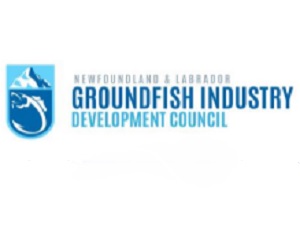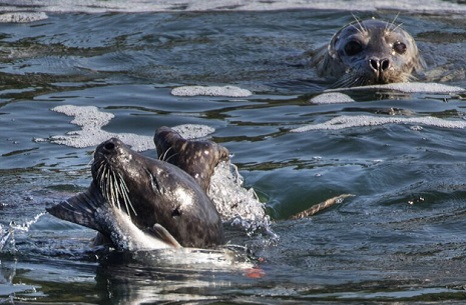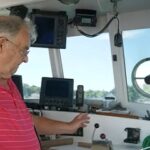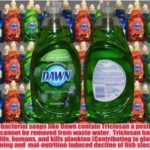Tag Archives: seals
Canada Expands Seal Harvest Licences in NB, PEI
 Seal harvesting is an important and valuable activity for many Indigenous and non-Indigenous communities. In Canada, it is managed in a sustainable, well-regulated, and humane way that supports Canada’s Indigenous, rural, remote, and coastal communities. In response to growing interest in participating in the seal harvest, today, the Honourable Diane Lebouthillier, Minister of Fisheries, Oceans and the Canadian Coast Guard, announced that personal use seal licences will be available to harvesters in New Brunswick and Prince Edward Island. The focus of this harvest is harp and grey seals which DFO assesses to be in the healthy zone of the Department’s precautionary approach framework. more, >>CLICK TO READ<< 13:43
Seal harvesting is an important and valuable activity for many Indigenous and non-Indigenous communities. In Canada, it is managed in a sustainable, well-regulated, and humane way that supports Canada’s Indigenous, rural, remote, and coastal communities. In response to growing interest in participating in the seal harvest, today, the Honourable Diane Lebouthillier, Minister of Fisheries, Oceans and the Canadian Coast Guard, announced that personal use seal licences will be available to harvesters in New Brunswick and Prince Edward Island. The focus of this harvest is harp and grey seals which DFO assesses to be in the healthy zone of the Department’s precautionary approach framework. more, >>CLICK TO READ<< 13:43
Seal oil is the best source of omega-3 and other facts about Canada’s misunderstood seal harvest
 Contrary to narratives spun by anti-sealing groups for decades, this practice is a testament to resilience and a crucial pillar of sustainability and economic survival. Despite numerous fear factors, some substantiated and others frivolous, coastal communities still rely on and support the responsible harvest of seals. For coastal Canadians, the ocean has been and continues to be a source of food, economic activity, recreation, and livelihood. Let’s follow the facts trail: The seal harvest uses techniques designed by a panel of international expert veterinarians. Seals eat 53 times more fish yearly than the entire Eastern Canadian fishing fleet catches. Government scientists have stated that seal predation is preventing the rebuilding of five fish species listed under the Species at Risk Act. >> click to read <<14:52
Contrary to narratives spun by anti-sealing groups for decades, this practice is a testament to resilience and a crucial pillar of sustainability and economic survival. Despite numerous fear factors, some substantiated and others frivolous, coastal communities still rely on and support the responsible harvest of seals. For coastal Canadians, the ocean has been and continues to be a source of food, economic activity, recreation, and livelihood. Let’s follow the facts trail: The seal harvest uses techniques designed by a panel of international expert veterinarians. Seals eat 53 times more fish yearly than the entire Eastern Canadian fishing fleet catches. Government scientists have stated that seal predation is preventing the rebuilding of five fish species listed under the Species at Risk Act. >> click to read <<14:52

Fishing communities ‘suffering from impact of growing seal colonies’, says MP
Sally-Ann Hart said “sound systems to deter seals are not appropriate” and that fishermen off the coast of her constituency Hastings and Rye were “suffering”. Environment minister Mark Spencer said the Government was working alongside the Marine Management Organisation to assess “non-lethal deterrent options” to keep seals away from fishing catches. Ms Hart said: “Off the coast of beautiful Hastings and Rye, fishermen are suffering from the impact of a growing seal colony affecting their fishing. “Due to the nature of the fishing, small boats leave their nets in the water, sound systems to deter seals are not appropriate. What steps is the minister taking to ensure that seals do not result in our fishing communities being decimated, let alone the fish?”>>click to read<< 13:14

Sea lions, seals might be hampering WA salmon recovery. What can be done?
State officials are now exploring whether to kill sea lions and seals in the Salish Sea and outer coast in a desperate effort to save salmon species from extinction. A new report commissioned by the state Legislature and completed by the Washington Academy of the Sciences says seals and sea lions are likely impeding salmon recovery, and the full impacts of predation on salmon may not be fully understood without lethal intervention. Three mammals specifically have skyrocketed. From 1975 to 2015, the harbor seal population in the Salish Sea exploded from about 6,000 to around 50,000. And California sea lions rose from 50,000 to somewhere around 300,000 on the West Coast of the U.S., according to the Northwest Indian Fisheries Commission. Populations of Steller’s sea lions living around Washington, Oregon and California steadily rose from an estimated 15,000 in 1982 to more than 43,000 in 2019. >click to read< 09:14

Make-or-break moment for province’s Liberal MPs; seal vote goes before Parliament on Wednesday
Seaward Enterprises Association of Newfoundland and Labrador (SEA-NL) is calling on the province’s six Liberal Members of Parliament to vote for a bill before Parliament Wednesday (July 15th) that would force Fisheries and Oceans to implement seal management plans. “This is one of those make-or-break moments for our Members of Parliament when they must decide whether they represent Newfoundland and Labrador in Ottawa or the other way around,” says Ryan Cleary, Executive Director of SEA-NL, and a former NDP MP. “Seals eat fish just as surely as MPs need votes.” Bill C-251 calls on the federal minister of Fisheries and Oceans to develop management plans for pinnipeds — including seals, sea lions, and walruses on the East and West coasts and Northern Canada. >click to read< 09:00

Are sea lions and seals eating too much of B.C.’s salmon? The answer may lead to a cull
An increasing number of the protected seals and sea lions (larger than seals, sea lions can walk) may be upsetting the balance of the British Columbia marine ecosystem. Now some First Nations are proposing a cull. “Environmentalists trying to stop traditional seal and sea lion hunts … are trying to starve out the Indians,” says Tom Sewid of the Kwakwak’wakw First Nation on northeastern Vancouver Island. “I won’t put up with it.” And as seals and sea lions have prospered, salmon have struggled. “The demise of the salmon runs in British Columbia is equivalent if not greater than the extinction of the great buffalo herds across the Great Plains” in the 1800s, says Sewid. > click to read < 09:01

Ireland: Seals depleting salmon stocks?
The potentially detrimental effect seals are having on salmon stocks has been raised at Donegal County Council’s Fisheries committee. Cllr McDermott said the seal population had quadrupled and he did not think any investigations had been carried out into the amount of salmon being eaten by seals. He added: “The effect on the salmon stock caused by seals is not being taken into consideration at all. The fishermen have grave concerns. It seems to be okay for the seals to deplete salmon stocks but it is not okay for the fisherman who is trying to make a living.” >click to read< 16:30

NLGIDC provides commentary on the latest scientific assessment for 3Ps Cod
The stock is currently at a low level and growth of this important resource is being impeded by high natural mortality. Jim Baird, The Chairman of the NLGIDC said, “The level of natural mortality has been at the highest levels ever recorded for this stock in the most recent time period.” Baird continued, “Having a better understanding of the processes related to natural mortality is important to provide scientists the ability to make accurate projections related to stock growth.” It is clear that seals eat substantial quantities of cod and many industry representatives believe that seal consumption is likely contributing to this high natural mortality, however DFO scientists are not convinced this is the case. >click to read< 19:56

Non-Fishing Mortality Remains Key Concern in South Coast Cod Update
Today’s 3Ps cod stock assessment update delivered some good news for harvesters on the province’s south coast, but significant concerns regarding natural mortality and the untold impact of seal predation remain. “Fish harvesters on the south coast are looking for better science on this cod stock,” says FFAW-Unifor President Keith Sullivan. “Natural mortality has been driving the stock for many years. We already know that seals are eating a large amount of cod, but DFO needs their scientists to prove it first. Yet several years into this and we’ve made very little headway,” >click to read< 16:39

Southern Newfoundland cod stocks expected to be in ‘critical zone’ until early 2024
In a presentation of the assessment’s findings on Friday, stock assessment biologist Karen Dwyer said cod born in 2011 have been supporting the 3PS stock, between southern Newfoundland and St-Pierre-Miquelon, and the fishery over the last few years. She said “recruitment”, fish younger than two years old, have dropped to historically low levels. Very few fish have been born in any one year since 2011,,, Some factors affecting the health of the cod stock could be the changes in the ecosystem, said Dwyer. Meanwhile, the debate over whether seals are among the biggest reasons for the deterioration of the cod stock in 3Ps is far from over. >click to read< 15:50

Federal Liberals continue to destroy BC fisheries… it’s starting to look like the NFLD fishing moratorium
There are about 2,000 licensed commercial fishing licenses held by BC fishermen (pc governments now call them harvesters). Using that figure and adding in 2 crewmen (many fishing boats have more) means over 2,500 harvesters will lose their jobs… The sad part is that reducing the wild salmon fishery has its precedence on the east coast. Some might remember back in 1992, the federal government of the day established the Newfoundland  cod fishery moratorium. It was a cruel and duplicitous statement to call it a moratorium as 30 years later, and the commercial cod fishery remains closed. Cod have considerably recovered but are being caught by fisherman from Iceland, Greenland, Denmark, and a swarm of foreign-flagged fish factory trawlers just outside the 200-mile nautical limit. Codfish are also being consumed by a 5 million strong seal herd, which has quadrupled in size since the collapse of the seal fishery. >click to read< 18:38
cod fishery moratorium. It was a cruel and duplicitous statement to call it a moratorium as 30 years later, and the commercial cod fishery remains closed. Cod have considerably recovered but are being caught by fisherman from Iceland, Greenland, Denmark, and a swarm of foreign-flagged fish factory trawlers just outside the 200-mile nautical limit. Codfish are also being consumed by a 5 million strong seal herd, which has quadrupled in size since the collapse of the seal fishery. >click to read< 18:38

5 miles of seals: Newfoundland fisherman’s video fires up more debate about pinnipeds
Fisherman Jason Branton was steaming home after a crab fishing trip a week ago when he saw something he’d never witnessed before. The 45-ft longliner Gracie’s Adventure was about 60 miles out from Baccalieu Island, in Trinity Bay, on May 30 when Branton and the crew noticed seals all around them. They had encountered a large herd of seals, a patch about five miles wide,, adding this is also the time when capelin begin migrating inshore. Branton and his crew rely mainly on crab, capelin and cod for their fishing income. The question of the impact of seals on fish and shellfish stocks has been debated for years and become more heated in recent years,,, video, >click to read< 10:23

Nunavut’s fishing industry gets $3.2 million for exploration, promotion of six fishing and sealing projects
The Canadian Northern Economic Development Agency, also known as CanNor, announced the new funding on Thursday. The money will be distributed to six fishing and sealing projects throughout the territory. CanNor said that some of the funding is meant for promoting Nunavut’s fishing and sealing industries to new markets as well as for the promotion of redfish and char markets. A portion of the funding will be dedicated to studying the potential of small-scale inshore fisheries for three communities: Arviat, Kinngait and Sanikiluaq. >click to read< 18:55

A Magnitude of Evidence: Seal Processing Company Accusing DFO of ‘Hiding Evidence’ of Seal Predation
A group of sealers are accusing DFO of “hiding evidence” of seal predation on crab stocks and they intend to take the matter further if need be.,, This year’s crab stock assessment showed some improvement in certain areas, but fishing activity is still only a fraction of what it was 15 or 20 years ago and there is little information on the impact of natural predation on crab stock recovery.,,, Rideout claims they’re keeping the evidence to launch a possible court case against DFO—if necessary. >click to read and, listen to the audio< of Brad Rideout! We’re not just talking crab, and he describes it so even DFO can understand it! 13:36

VIDEO: Newfoundland fisherman provides proof seals eat crab – No Doubt!
When Natasha Rideout took a knife and cut through the thick membrane, more than 100 small crab spilled out, along with red clumps of crab roe. And that was just from one seal. The seals were caught by local fish harvester Trevor Jones, When cleaning the seal, the crew noticed that the stomachs were bursting with female snow crab, more than 100 in some. The company noted there are six species of seal found off the coast of Newfoundland and Labrador, all at the highest population ever recorded, and with few natural predators. The current quota for seals is 400,000 animals, but Rideout says only about 50,000 to 60,000 animals are taken each year. >video, click to read< 12:47

What to do about seals?
Atlantic Seal Science Task Team, Dear Sir/Madam, I wish to contribute input to the work of the Atlantic Seal Science Task Team related to DFO’s science activities and programs regarding seals, and the role of the animals in the ecosystem in Atlantic Canada and Quebec. To begin, I want to refer to the February, 1990 Independent Review of the State of the Northern Cod Stock by the late Dr. Leslie Harris, a report that questioned the impact of seals on the marine ecosystem. The Review Panel, which held a series of province-wide public hearings at the time, was “repeatedly confronted” by inshore fishermen with the issue of the growth of the seal herds, and the impacts on the abundance of cod.,, >click to read< By Ryan Cleary 12:04

New “Gadget”? Underwater noisemaker to scare away seals at Ballard Locks
On a recent morning, after some acrobatics and horsing around, a seal cruising the locks suddenly took an all-business turn. When it resurfaced, it was with a mouth crammed full of coho. The Hiram Chittenden Locks, built more than 100 years ago, allow navigable access from the freshwater of Lake Washington and Lake Union to Puget Sound. But the locks also inadvertently created an attraction for seals. The concrete chute of the locks concentrates salmon, making easy pickings. As salmon runs have declined in Puget Sound, a range of methods has been tried over the years to shut down the buffet. Underwater firecrackers, pingers, even Fake Willy, a faux orca that used to be lowered into the channel in an attempt to scare off seals and sea lions. Now a new gadget is being tested at the locks, intended to startle seals to deter them. >click to leave< 20:20

Can New England’s cod fishing industry survive? (How can the scientists and regulators ignore the ever increasing seal predation?!)
Gloucester, Massachusetts, grew up around cod. The waterfront teemed with boats and fishermen, heaps of fish thrashing in wire baskets. Boats were inherited from fathers and shipyards boasted of operating since 1684. As late as the 1980s, the cod were so abundant and large (30-50lb each) that the fishermen still brought in big hauls. Cod remains the state fish of Massachusetts., “We’ve been regulated out of existence,” former Gloucester fisherman Sam Sanfilippo said in 2017. “This used to be the biggest fishing community in the world. Ice companies, wharves, fish dealers, truckers, supermarkets … All through high school, I was always a fisherman. And here I am today: recycler, bike seller, furniture-maker. “I’m 50 years old and I don’t know what the hell I am.” >click to read< 07:30
Canada to ban ‘nuisance seals’ killing to keep access to U.S. market – Canada will abolish permits that allow the killing of “nuisance seals” by commercial fishermen and aquaculture in an effort to maintain access to the lucrative U.S. seafood market, Fishery management failure enacted for fish farmers >click to read<

Environmentalists are dragging us back to the Dark Ages
In the early 1990s, our small group of Potlatch employees in cooperation with members of the Lewiston and Clarkston chambers of commerce were researching environmental claims that the lower Snake River dams were devastating salmon runs, when we learned about East Sand Island, a man-made island in the estuary of the Columbia River. The island was formed from dredging deposits in 1983 and by 1984, Caspian terns, cormorants and gulls had colonized the island and were feasting on salmon smolts. We thought: “Wow, this is an easy fix. Tear out a man-made island and save millions of endangered fish.” The environmentalists beat us to the punch. They filed in federal court to protect the island and the birds under the Migratory Bird Treaty Act of 1918. Now we have the largest nesting colony of these non-endangered birds in the world on a man-made island. by Marvin Dugger >click to read< 09:50

No Action! Seal problem still not being dealt with
Here we go again DFO sciences saying the cod stocks are still declining and they blamed everything under the sun for the reason of the decline except the real reason which are the seals. The seals are not only putting the cod stocks in danger but also the Atlantic salmon stocks, the crab stocks and the saltwater trout stocks etc. Neil Smith, >click to read< 17:44

“Human Dimension of Rebounding Population of Seals and White Sharks on Cape Cod.” Study targets public’s views about seals
“We want to bring different perspectives together to see what people value about Cape Cod, see what they understand about the marine ecosystem and the interactions within it,” said George Maynard, research coordinator at the Cape Cod Commercial Fishermen’s Alliance, one of the collaborating organizations. “Seals are one piece in an increasingly complicated environment.” Jennifer Jackman, a professor of political science at Salem State University, is leading the study, “Human Dimension of Rebounding Population of Seals and White Sharks on Cape Cod.” >click to read< 13:12

LETTER: Standing up for our fishery
A famous Newfoundland and Labrador politician was once asked about the impact of seals on the fish stocks off our coast. He replied using the wit many good Newfoundland orators are known for and said something to the effect of well, they don’t eat Kentucky Fried Chicken. He was absolutely right then and the same holds true today as we see thousands of tons of fish consumed daily off our shores by these cute-looking mammals with voracious appetites for cod, crab and other lucrative species; the same fish our harvesters and processors depend on,,, by Paul Lane >click to read< 07:21

The impacts of seals and cormorants experienced by Baltic Sea commercial fishers
The growth of seal and cormorant populations has challenged the viability of coastal fisheries in the Baltic Sea. In 2017 widely spread frustration among local and regional fishery stakeholders generated a transnational cooperation project operated by the Fisheries Local Action Groups. The Baltic Sea Seal and Cormorant project aimed at producing new knowledge of the seal and cormorant induced problems, and at raising public awareness about the troubled situation in the Baltic Sea area. >click to read the study< 14:02

Managing Coorong seals could provide local jobs, say Indigenous elders
The number of seals in the region has increased dramatically in the past five years, and many fishermen have called for a cull. But Indigenous elders in the Lower Lakes and Coorong region said there could be other ways to manage the seals.,,, A recent senate inquiry recommended culling overabundant species, such as corellas and kangaroos, when the pests’ impact on the community warrants it. But South Australian Environment Minister David Spiers said in the case of the Coorong seals, more research was needed before the State Government would consider a cull. >click to read< 16:24

Seals are overfishing at unsustainable rates! Gulf of St. Lawrence cod extinction ‘highly probable,’
“At the current abundance of grey seals in this ecosystem, recovery of this cod population does not appear to be possible, and its extinction is highly probable,” the report says. DFO fish biologist Doug Swain said the cod population is now about five per cent of levels in the 1980s, and the downward spiral is accelerating despite a moratorium on a directed cod fishery in the Gulf since 2009. The problem is an “extremely high” and “unsustainable” death rate for cod five years or older. >click to read< 11:29

Naturalist Peter Trull: Don’t Blame The Seals
Why are there virtually no codfish to be found in the waters off Cape Cod? Depending on who you ask, it’s because of the eating habits of the thousands of gray seals now living in local waters, or it’s because of decades of chronic overfishing plus ecological changes, like warming oceans. Peter Trull, Pleasant Bay Community Boating Curriculum Developer and Naturalist, comes down squarely on the latter cause. He calls blaming the seals “the biggest misconception” that exists on this topic today. >click to read< 07:18

EDITORIAL: Ocean imbalance
Fisheries scientists, writing in the Canadian Journal of Fisheries and Aquatic Sciences, suggest that the southern Gulf of St. Lawrence cod stock may be extinct by 2050, because cod five years old and older now face an annual mortality rate of 50 per cent. The stock was already hit hard by the fishery, and collapsed in the 1990s. But it’s still not rebounding, even after years of limited fishing, and the scientists suggest that could be because the cod congregate to spawn, and are easy targets for the Gulf grey seal population, whose numbers have grown from around 6,000 in the 1960s to 100,000 in 2014. >click to read<08:20
















































